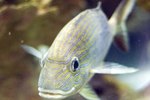With their large size, handsome colors and feisty personalities, pink-tailed chalceus fish (Chalceus macrolepidotus) are stimulating aquarium pets. They're not much bigger than goldfish, reaching about 10 inches in length compared with a goldfish's 8, but the chalceus is a lot less laid-back than the goldfish and the chalceus' needs differ. Before acquiring one as a pet, bear in mind keeping the pink-tailed chalceus is a long-term commitment. The fish needs a lot of space and does not get on well with certain other fish.
Habitat
Set up the largest tank you can afford and have space for, at least 50 gallons but preferably larger. Apart from its size, the pink-tailed chalceus requires a lot of space because it's an active species that needs to swim. Include dark-colored gravel or sand, a heater, filter and aquatic plants. Aquatic Community recommends including a few flat, floating plants to control light levels. Other decorations are optional and more for your aesthetic enjoyment than for the fish. The pink-tailed chalceus appreciates swimming space more than hiding places. Allow the tank to cycle fully before introducing fish.
Special Considerations
As Fish Base notes, this species has a habit of jumping. Ensure that the lid fits securely. The chalceus is also quite strong. Consider adding a latch, or acquiring a more suitable lid, if the lid is flimsy or loose. Maintain a temperature of about 72 to 82 degrees F. This species tolerate a range of pH levels, from 6 to 7.5, so maintaining the water should require comparatively limited effort. According to Seriously Fish, the pink-tailed chalceus can live up to 15 years if cared for properly. This is not a pet to adopt if you don’t know what you’ll be doing or where you’ll be in a few years’ time. Fish are not easy animals to re-home.
Feeding
Chalceus macrolepidotus is a carnivorous or meat-eating species. Feed your fish on pellets for carnivorous fish and chopped meaty foods, such as shrimp, supplemented with some live food, such as bloodworms. As they are adapted to hunting live prey, they might not eat pellets or chunks that have sunk to the bottom -- so drop them in one or two at a time, not all at once.
Tankmates
Because the pink-tailed chalceus is a territorial fish, the social interactions of small groups -- those of two to five individuals -- can get intense and aggressive. This fish is best kept to his own tank or with different species, or in a single-species group of a dozen or more fish if you have the space. Pink-tailed chalceus fish can live in a community tank provided the other fish are of about the same size and nature. Smaller or more peaceful species are liable to get eaten or bullied. Good tank mates, assuming the aquarium has enough space, are cichlids and other characins of about the same size. Unless you want them to become snacks for your chalceus, do not include any fish that are small enough to be swallowed.
References
Writer Bio
Judith Willson has been writing since 2009, specializing in environmental and scientific topics. She has written content for school websites and worked for a Glasgow newspaper. Willson has a Master of Arts in English from the University of Aberdeen, Scotland.




